Trees of the Adirondacks:
Red Maple (Acer rubrum)
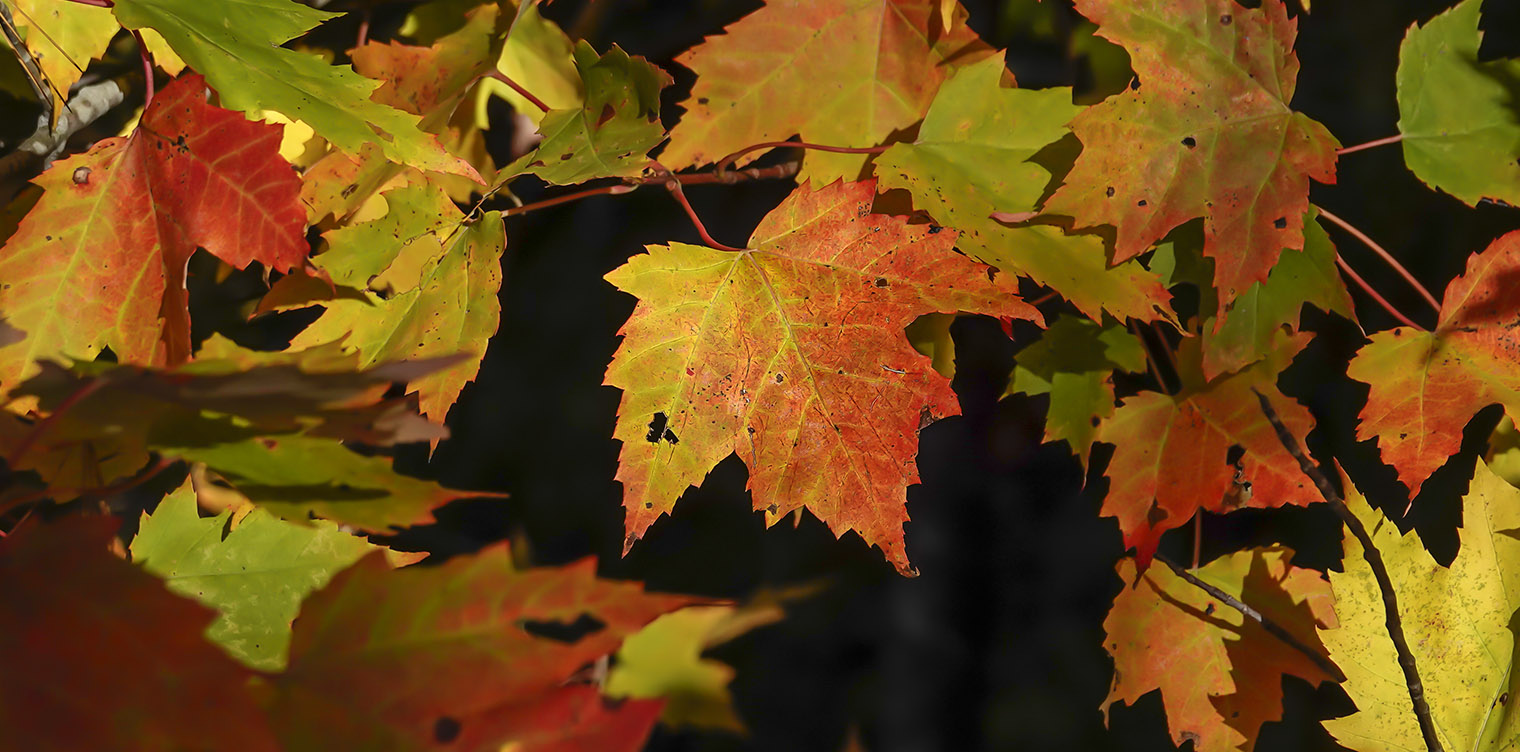
The Red Maple (Acer rubrum) is a medium to large deciduous tree that flourishes in a variety of habitats in the Adirondack Mountains. It is one of the most abundant and widespread trees in eastern North America.
The Red Maple's common name reflects the fact that its flowers, fruits, leaf stalks, and autumn colors are red or reddish. This species is also known as Scarlet Maple, Swamp Maple, Soft Maple, Carolina Red Maple, and Water Maple. The Red Maple is the state tree of Rhode Island.
Identification of the Red Maple
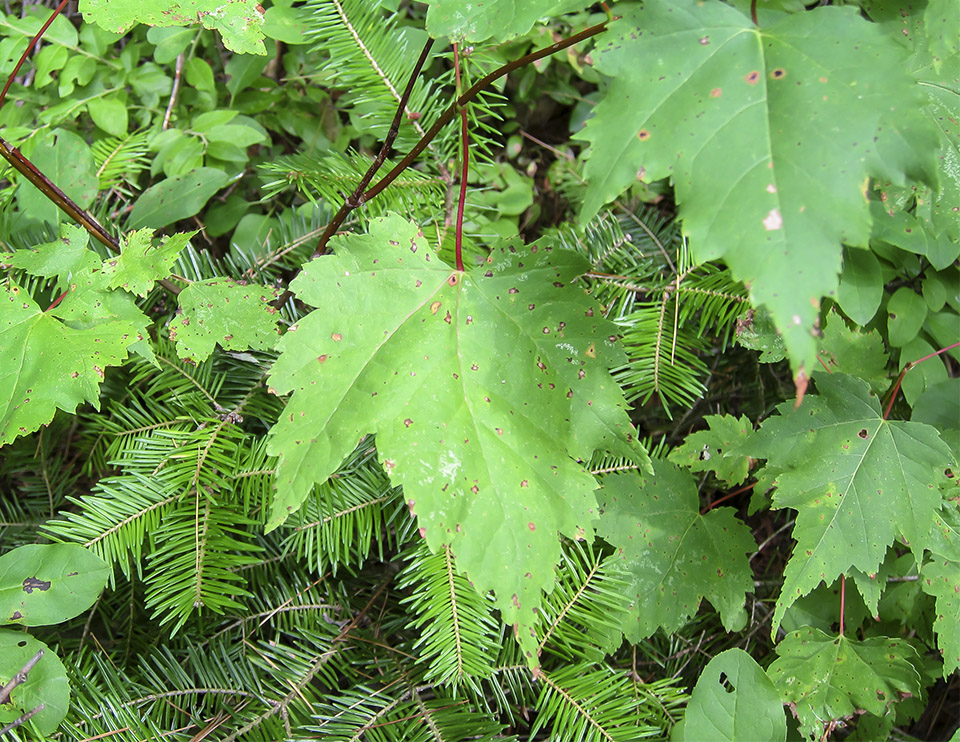
Red Maple trees have an erect, single trunk. This species grows 30 to 90 feet tall and up to 4 feet in diameter. Like other maples, the branches of Red Maples are meaning that the branches are directly across, or opposite, each from other. The twigs and buds of Red Maple trees are reddish.
Reds Maple leaves are simple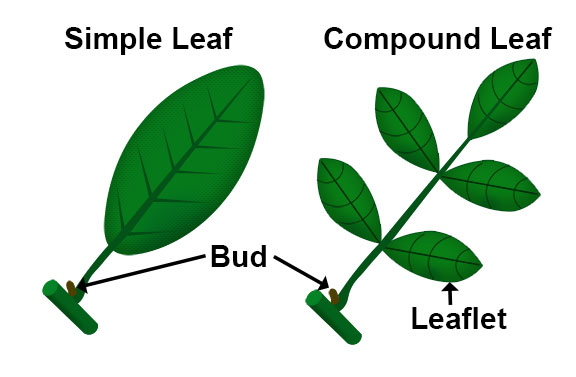 Simple Leaf: A leaf with a single undivided blade, as opposed to a compound leaf, which is one that is divided to the midrib, with distinct, expanded portions called leaflets.
Simple Leaf: A leaf with a single undivided blade, as opposed to a compound leaf, which is one that is divided to the midrib, with distinct, expanded portions called leaflets. Simple Leaf: A leaf with a single undivided blade, as opposed to a compound leaf, which is one that is divided to the midrib, with distinct, expanded portions called leaflets., meaning that each leaf has a single blade. The leaves are opposite
Simple Leaf: A leaf with a single undivided blade, as opposed to a compound leaf, which is one that is divided to the midrib, with distinct, expanded portions called leaflets., meaning that each leaf has a single blade. The leaves are opposite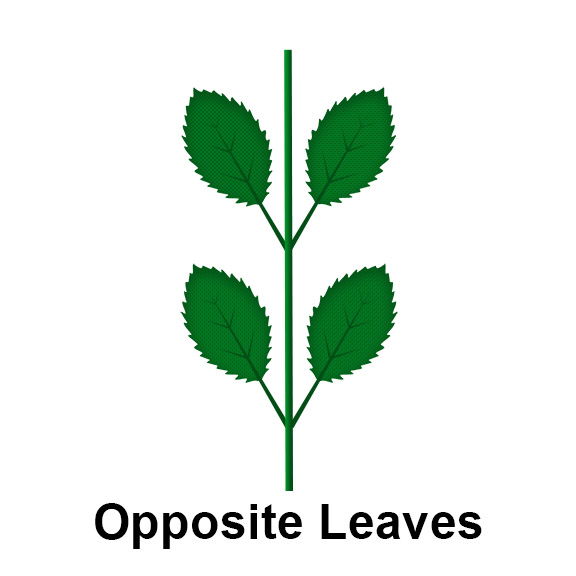 Opposite Leaves: Leaves occurring in pairs at a node, with one leaf on either side of the stem. and lobed.
Opposite Leaves: Leaves occurring in pairs at a node, with one leaf on either side of the stem. and lobed.
- Red Maple leaves generally have three major lobes
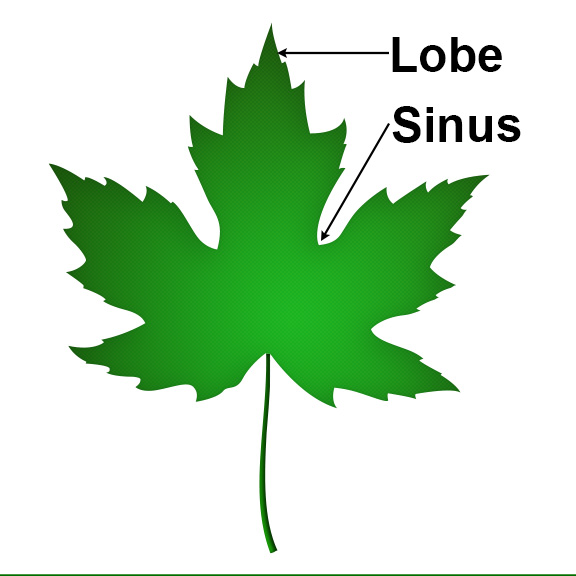 Lobe: A projection from an edge of a plant structure (such as a leaf), larger than a tooth. Lobed leaves are leaves with distinct protrusions, either rounded or pointed., sometimes with two additional smaller lobes near the base of the leaf. The tips of the lobes are narrowly pointed.
Lobe: A projection from an edge of a plant structure (such as a leaf), larger than a tooth. Lobed leaves are leaves with distinct protrusions, either rounded or pointed., sometimes with two additional smaller lobes near the base of the leaf. The tips of the lobes are narrowly pointed. - The notches or dips between the lobes are V-shaped.
- The margins of the leaf are toothed
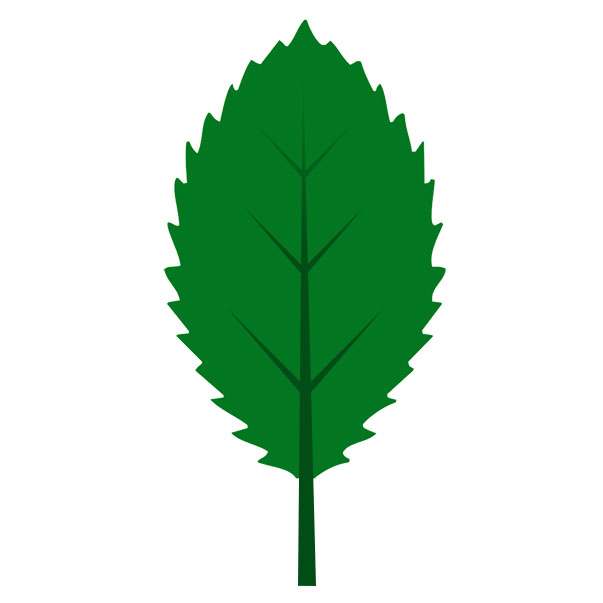 Toothed: Leaves which have a saw-toothed edge.. The teeth are coarse.
Toothed: Leaves which have a saw-toothed edge.. The teeth are coarse. - When mature, the leaves are dull green and smooth above, lighter green or silvery beneath and more or less hairy.
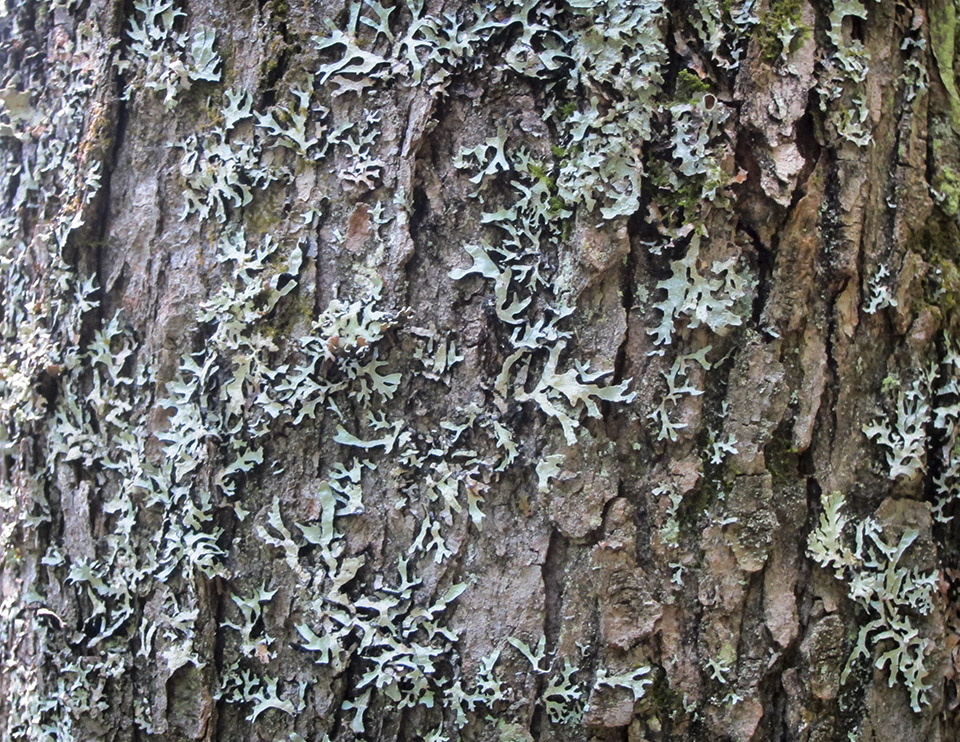
Like many other trees, the bark of Red Maples changes as the tree matures. This means that for Red Maple, as for many other trees, bark is not a particularly useful characteristic to rely on for distinguishing Red Maple from other trees, such as Sugar Maple, which have somewhat similar bark.
The bark of a young Red Maple is smooth. In color, it is usually light ash-gray, almost silver. As the tree ages, the texture and color of the bark changes. It darkens, and eventually vertical cracks develop.
On older and larger trees, the vertical cracks form multiple layers of long, vertical plates. The plate-like strips remain fastened in the center, but can occasionally curl outward on one or both ends.
Red Maples can become infected by "target canker." This is a fungus which causes the bark to crack in concentric circles, forming bullseye-shaped raised plates that look like a target. The canker reportedly can persist for many years without killing its host.
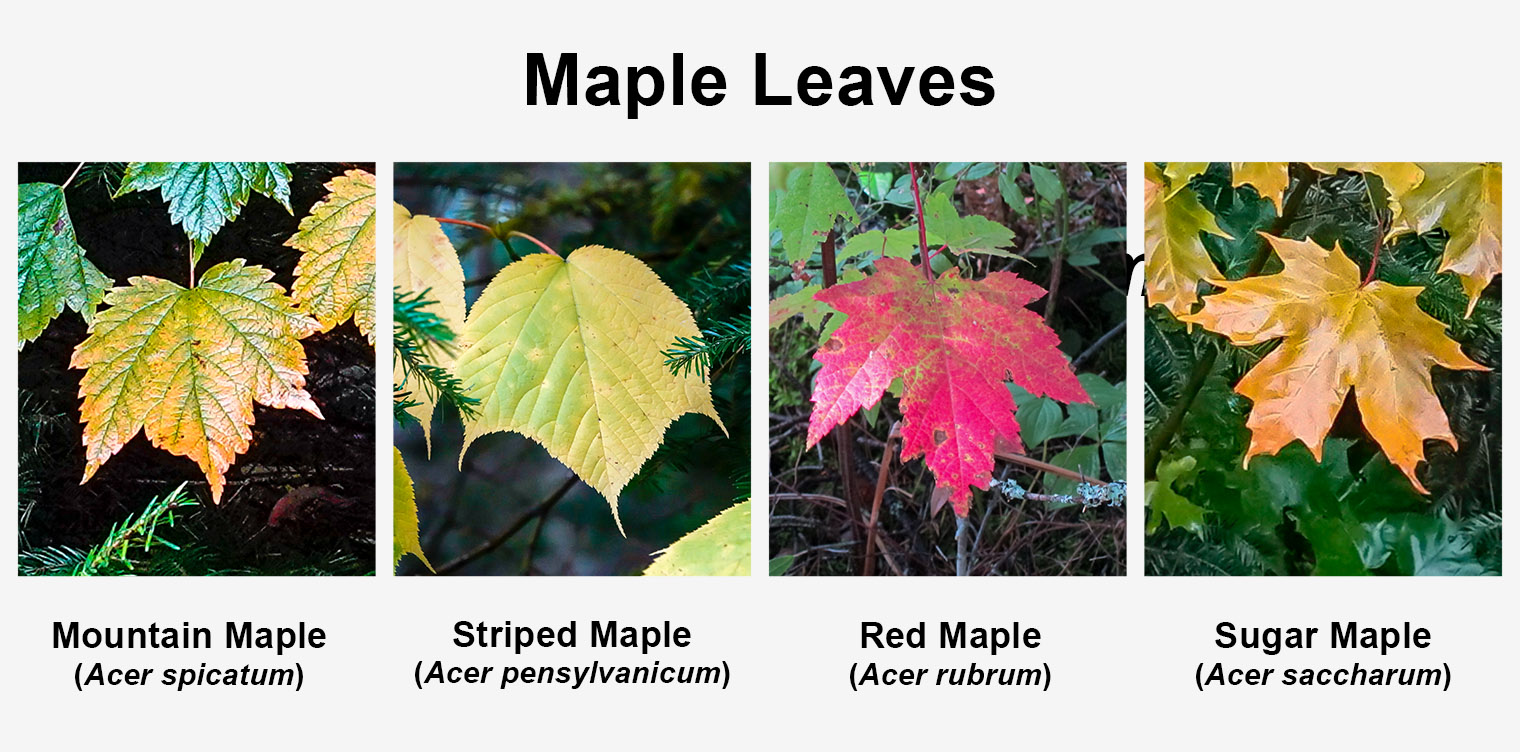
Keys to identifying the Red Maple and differentiating it from other maples include its leaves, bark, growth habit, and habitat.
- The leaves of the Sugar Maple and the Red Maple have a similar shape. However, Red Maple leaves are coarsely toothed. The Sugar Maple, by contrast, has just a few pointed tips on each lobe. Also, the dips between the lobes of the Red Maple are pointy, forming a sharp "v," while those between the lobes of the Sugar Maple are u-shaped.
- Although Red Maple, Striped Maple, and Mountain Maple all have toothed leaf margins, the shape of Red Maple leaves is different from those of the Striped Maple and Mountain Maple. Red Maple leaves are more deeply lobed than those of the Striped Maple and Mountain Maple.
- The bark of the Red Maple contrasts with that of the Striped Maple, which is marked with distinctive stripes.
- The growth habit of the Red Maple is similar to that of the Sugar Maple, but contrasts with that of both the Striped Maple and the Mountain Maple. Both of these latter species are much smaller. The Striped Maple is a small tree or large shrub, often divided into several branches from near the base, while the Mountain Maple is a shrubby tree.
- Habitat is another clue distinguishing the Red Maple from the Sugar Maple. Red Maple trees are more tolerant of wet soil. A large, single-trunked maple tree growing near a marsh or other wetland is most likely to be a Red Maple.
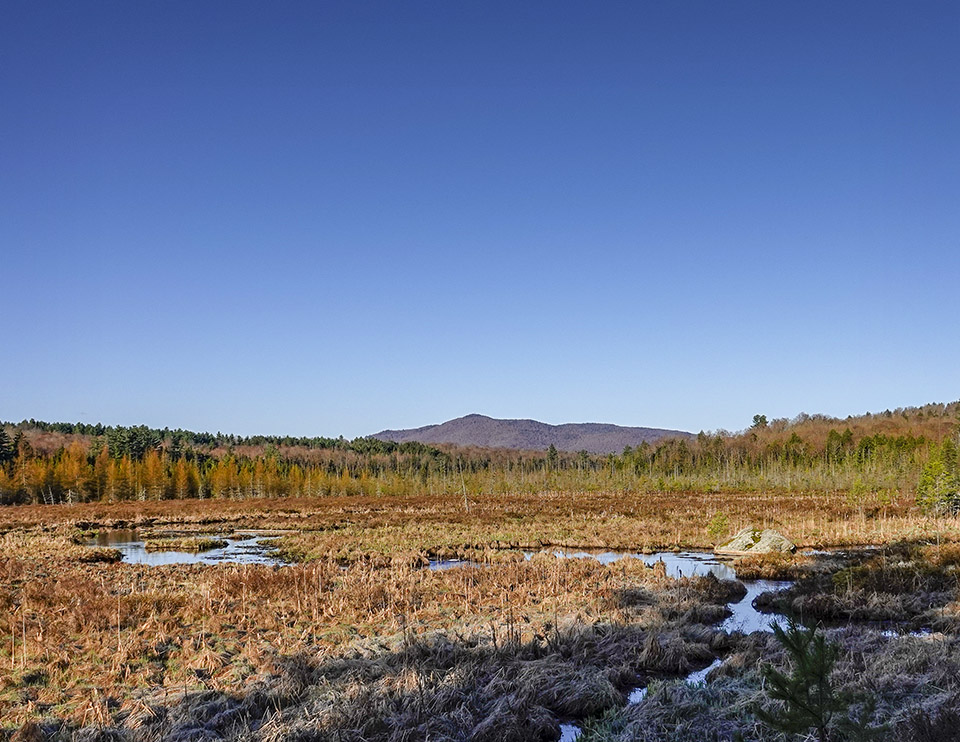
Red Maple is one of the first trees to flower in the spring, generally several weeks before the leaves appear. The flowers are small, with slender stalks, pink to red. Flowering occurs on all branches in the upper portion of the crown. In our area, Red Maples usually flower the first and second weeks in May.
The winged seeds (samaras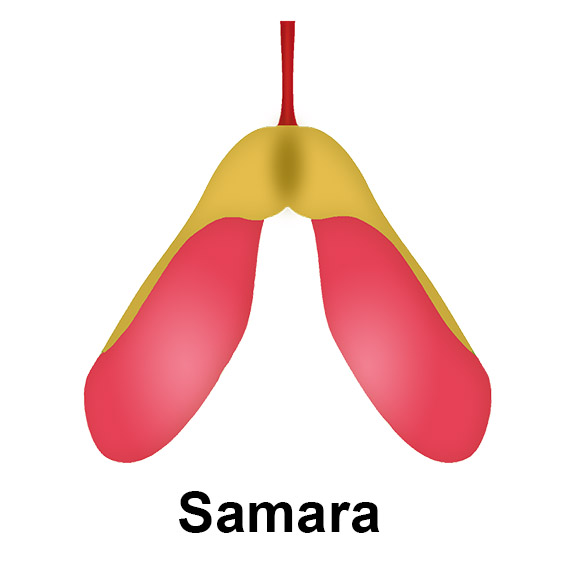 Samara: A type of dry fruit where one seed is surrounded by papery tissue that helps carry the seed away from the tree as the wind blows. ) of the Red Maple are the smallest of all native maples, about 5/8-3/4 inches long. The samaras ripen in the spring, usually the first week of June in the Adirondacks.
Samara: A type of dry fruit where one seed is surrounded by papery tissue that helps carry the seed away from the tree as the wind blows. ) of the Red Maple are the smallest of all native maples, about 5/8-3/4 inches long. The samaras ripen in the spring, usually the first week of June in the Adirondacks.
The Red Maple is one of the early harbingers of autumn as it turns color well in advance of other eastern deciduous trees, especially when it is located in wet sites. The fiery colors of fall are typically a brilliant red.
Uses of the Red Maple
The wood of the Red Maple is not particularly desirable for lumber or veneer. Red Maple is known in the lumber industry as soft maple. The wood is close grained and resembles that of the Sugar Maple, but is softer in texture and has somewhat poorer machining qualities. The Red Maple is a popular landscaping tree for its brilliant fall foliage, smoky red male flowers in spring, and red samaras on female trees.
The Red Maple was used by various native American tribes to make spoons, arrow heads, baskets, and bowls. Leaves of the Red Maple were frequently used in the Ojibwe bead work designs. Native Americans also used the sap to make sugar and syrup. The Iroquois dried, pounded, and sifted the bark to make into bread. The plant was also used for medicinal purposes. For instance, the Cherokee used an infusion for hives and boiled the inner bark with water as an eyewash. Pioneers reportedly made ink and cinnamon-brown and black dyes from a bark extract.
Wildlife Value of the Red Maple
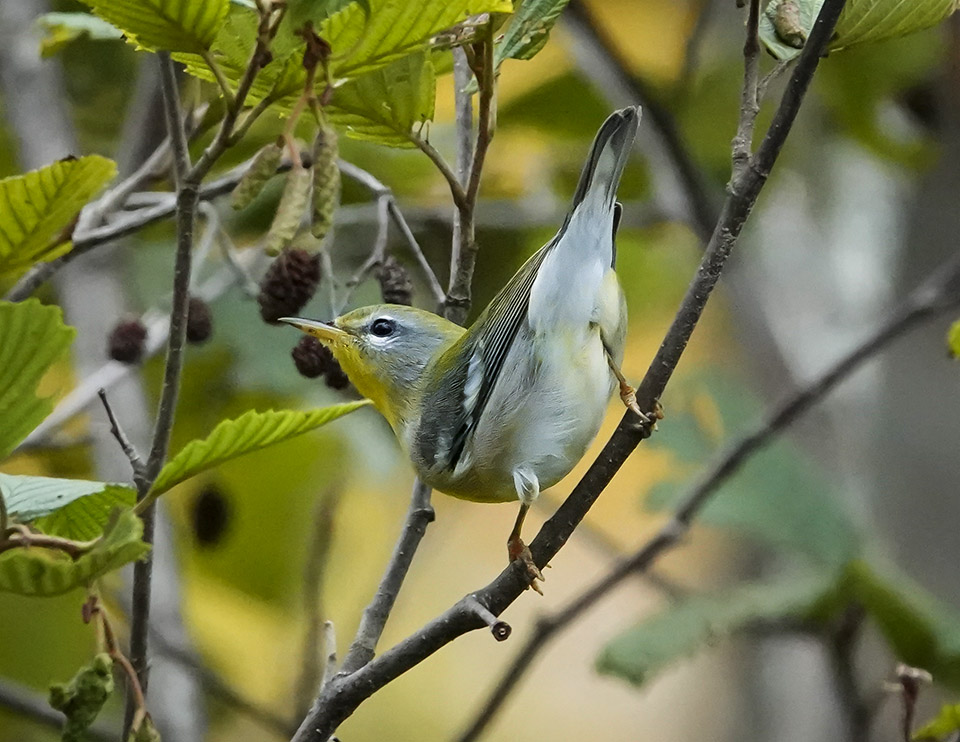
Red Maple leaves, twig, bark, and fruits provide a food source for numerous mammals, birds, and insects. However, Red Maple leaves are extremely toxic to horses and cattle. The species is not preferred by deer as a browse source, so in areas with heavy deer pressure, this species is over-abundant in forest regeneration. The Red Maple is a larval host for the Rosy Maple Moth. Red Squirrels use the cavities of older trees as nesting habitat.
A number of birds build nests in Red Maples, including American Redstarts, Black-backed Woodpeckers, and Downy Woodpeckers. Woodpeckers and other insectivorous songbirds often search for the many insects that feed on maples; these insects are especially important in feeding young nestlings. For instance, Red Maple stands are a preferred micro-habitat for foraging for Red-eyed Vireos.
The Red Maple is a common tree species in the breeding habitat of a wide variety of birds, including:
Distribution of the Red Maple
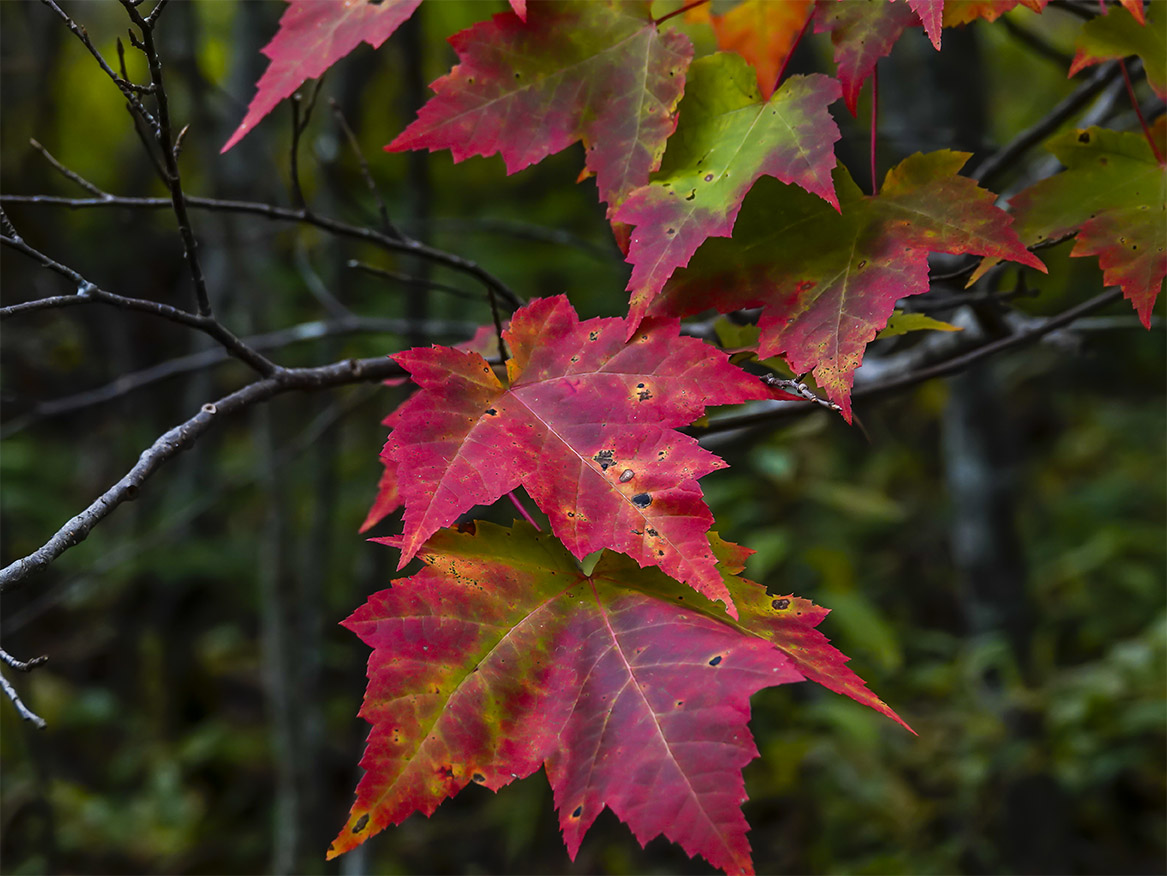
Red Maple is one of the most abundant and widespread trees in eastern North America, occurring in a diverse array of ecological conditions. It grows from southern Newfoundland, Nova Scotia, and southern Quebec to southern and southwestern Ontario, extreme southeastern Manitoba, and northern Minnesota; south to Wisconsin, Illinois, Missouri, eastern Oklahoma, and eastern Texas; and east to Florida. The Red Maple is most common in New England, the Middle Atlantic States, upper Michigan, and northeast Wisconsin. It is rare farther west and south.
In New York State, Red Maples are present in most counties throughout the state. This species can be found in all counties in the Adirondack Park Blue Line.
Habitat of the Red Maple
The Red Maple can grow over a wide range of water table depths, soil depths, and soil textures. Red Maples grow in both dry soils and wet soils. Of all the broad-leaved trees present in the Adirondacks, Red Maple is the one best able to grow where its roots are submerged. It can even grow in bogs, although it will not thrive there.
In general, this tree is common in places where Sugar Maple is unable to dominate, especially in poorly drained, shallow, or sandy soils. Moderately shade-tolerant, Red Maple will grow almost anywhere except in dense shade. This species is usually categorized as a subclimax species.
Red Maple can be found in a wide variety of ecological communities in the Adirondack Park:
In the Adirondacks, you can find individual Red Maple trees growing along virtually all of the trails covered here, in both Northern Hardwood Forests and Mixed Wood Forests.
- For instance, in a Beech-Maple Mesic Forest, a northern hardwood forest with Sugar Maple and American Beech codominant, look for Red Maples scattered among Yellow Birch and Striped Maple.
- Characteristic shrubs include Hobblebush and Alternate-leaved Dogwood, growing alongside Sugar Maple and American Beech saplings.
- Characteristic wildflowers include Canada Mayflower, Common Wood Sorrel, Jack-in-the-Pulpit, and Wild Sarsaparilla, as well as spring ephemerals such as Trout Lily.
- Ferns that flourish in this habitat include Intermediate Wood Fern, Spinulose Woodfern, and Christmas Fern.
Adirondack Tree List
References
Michael Kudish. Adirondack Upland Flora: An Ecological Perspective (Saranac, New York: The Chauncy Press, 1992), pp. 54, 56-57, 169.
E. H. Ketchledge. Forests and Trees of the Adirondack High Peaks Region (Adirondack Mountain Club, 1996), pp. 139-143.
Edwin H. Ketledge, "The Maples of New York," New York State Conservationist, Volume 16, Number 5 (April-May 1962), pp. 31-32. Retrieved 21 September 2020.
New York Flora Association. New York Flora Atlas. Common Red Maple. Acer rubrum L. var. rubrum. Retrieved 8 March 2017.
United States Department of Agriculture. Forest Service. Silvics of North America. Red Maple. Retrieved 8 November 2019.
United States Department of Agriculture. The Plants Database. Red Maple. Acer rubrum L. var. rubrum. Retrieved 8 March 2017.
United States Department of Agriculture. Fire Effects Information System (FEIS). Species Reviews. Acer rubrum. Retrieved 8 March 2017.
New York State. Department of Environmental Conservation. New York Natural Heritage Program. Ecological Communities of New York State. Second Edition (March 2014), pp. 119-120, 121-122, 125. Retrieved 17 October 2015.
New York Natural Heritage Program. 2022 Online Conservation Guide for Beech-Maple Mesic Forest. Retrieved 29 March 2022.
New York Natural Heritage Program. 2022. Online Conservation Guide for Black Spruce-Tamarack Bog. Retrieved 29 March 2022.
New York Natural Heritage Program. 2022. Online Conservation Guide for Floodplain Forest. Retrieved 29 March 2022.
New York Natural Heritage Program. 2022. Online Conservation Guide for Northern White Cedar Swamp. Retrieved 29 March 2022.
New York Natural Heritage Program. 2022. Online Conservation Guide for Pine-Northern Hardwood Forest. Retrieved 29 March 2022.
New York Natural Heritage Program. 2022. Online Conservation Guide for Red Maple-Tamarack Peat Swamp. Retrieved 29 March 2022.
New York Natural Heritage Program. 2022. Online Conservation Guide for Silver Maple-Ash Swamp. Retrieved 29 March 2022.
New York Natural Heritage Program. 2022. Online Conservation Guide for Spruce Flats. Retrieved 29 March 2022.
iNaturalist. Red Maple. Acer rubrum. Retrieved 30 August 2021.
iNaturalist. Adirondack Park Observations. Red Maple. Acer rubrum. Retrieved 30 August 2021.
New York State. Adirondack Park Agency. Preliminary List of Species Native Within the Adirondack Park Listed Alphabetically by Scientific Name and Sorted by Habit. Volume 1. Updated 10.23.2006, p. 4. Retrieved 26 January 2017.
Lady Bird Johnson Wildflower Center. Native Plant Database. Retrieved 25 January 2015.
University of Wisconsin. Trees of Wisconsin. Acer rubrum. Retrieved 25 January 2015.
Online Encyclopedia of Life. Acer rubrum. Retrieved 25 January 2015.
University of Michigan. Native American Ethnobotany. A Database of Foods, Drugs, Dyes and Fibers of Native American Peoples, Derived from Plants. Red Maple. Acer rubrum L. Retrieved 8 March 2017.
Plants for a Future. Database. Retrieved 25 January 2015.
The Birds of North America. Purple Finch, Yellow-bellied Sapsucker, Alder Flycatcher, American Redstart, Veery, Hooded Warbler, Wood Thrush, Northern Parula, Red-eyed Vireo, Eastern Wood-Pewee, Canada Warbler, Black-backed Woodpecker, and Downy Woodpecker. Subscription Web Site. Retrieved 26 January 2015.
Ellen Rathbone, "Adirondack Tree Identification 101," The Adirondack Almanack, 18 November 2009. Retrieved 24 January 2015.
Michael Wojtech. Bark: A Field Guide to Trees of the Northeast (University Press of New England, 2011), pp. 94-97.
George A. Petrides. A Field Guide to Eastern Trees (Boston: Houghton Mifflin Company, 1998), pp. 54-55, 203-204.
George A. Petrides. A Field Guide to Trees and Shrubs (Boston: Houghton Mifflin Company, 1958,1972), pp. 7, 96-97, 120-121.
Gil Nelson, Christopher J. Earle, and Richard Spellenberg. Trees of Eastern North America (Princeton : Princeton University Press), pp. 624-625.
C. Frank Brockman. Trees of North America (New York: St. Martin's Press), pp. 212-213.
Keith Rushforth and Charles Hollis. Field Guide to the Trees of North America (Washington, D.C., National Geographic, 2006), p. 202.
National Audubon Society. Field Guide to North American Trees (New York: Alfred A. Knopf, 1980), Plates 261, 366, 369, 495, 593, pp. 577-578.
Allen J. Coombes. Trees (New York: Dorling Kindersley, Inc., 1992), p. 100.
